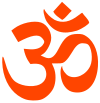Dyaus
| Dyaus | |
|---|---|
God of Sky and Heaven | |
| Other names | Akasha |
| Affiliation | Deva, Pancha Bhoota |
| Abode | Dyuloka, Sky (
IAST (IAST: IAST) , ) |
| Texts | Rigveda |
| Consort | Prithvi |
| Offspring | Surya, Ushas, and the other gods |
| Greek equivalent | Zeus |
| Roman equivalent | Jupiter |
| Part of a series on |
| Hinduism |
|---|
 |
Dyaus (/ˈdjaʊʃ/ DYOWSH), or Dyauspitar (Devanagari द्यौष्पितृ, IAST (IAST: IAST)
), is the Ṛgvedic sky deity. His consort is Prithvi, the earth goddess, and together they are the archetypal parents in the Ṛg·veda.
Name[edit]
IAST (IAST: IAST)
stems from Proto-Indo-Iranian *dyā́wš, from the Proto-Indo-European (PIE) daylight-sky god Template:PIE, and is cognate with the Greek Zeus Patēr, Illyrian Dei-pátrous, or Latin Jupiter (from an earlier *Djous patēr), stemming from the PIE Dyḗus ph₂tḗr ("Daylight-sky Father").[1]
The noun IAST (IAST: IAST)
(when used without the
IAST (IAST: IAST)
'father') refers to the daylight sky, and occurs frequently in the Ṛg·veda, as an entity. The sky in Vedic writing was described as rising in three tiers,
IAST (IAST: IAST)
,
IAST (IAST: IAST)
, and
IAST (IAST: IAST)
or
IAST (IAST: IAST)
.[2]
Role[edit]
Dyáuṣ Pitṛ́ appears in hymns with Prithvi Mata 'Mother Earth' in the ancient Vedic scriptures of Hinduism.[3]
In the Ṛg·veda, Dyáuṣ Pitṛ́ appears in verses 1.89.4, 1.90.7, 1.164.33, 1.191.6, 4.1.10. and 4.17.4[4] He is also referred to under different theonyms: Dyavaprithvi, for example, is a dvandva compound combining 'heaven' and 'earth' as Dyauṣ and Prithvi.
Dyauṣ's most defining trait is his paternal role.[5] His daughter, Uṣas, personifies dawn.[6] The gods, especially Sūrya, are stated to be the children of Dyauṣ and Prithvi.[7] Dyauṣ's other sons include Agni, Parjanya, the Ādityas, the Maruts, and the Angirases.[5][7] The Ashvins are called "divó nápāt", meaning offspring/progeny/grandsons of Dyauṣ.[5][8] Dyauṣ is often visualized as a roaring animal, often a bull, who fertilizes the earth.[5] Dyauṣ is also known for the rape of his own daughter, which is vaguely but vividly mentioned in the Ṛg·veda.[7]
Dyauṣ is also stated to be like a black stallion studded with pearls in a simile with the night sky.[5][9]
Indra's separation of Dyauṣ and Prithvi is celebrated in the Rigveda as an important creation myth.[7]
See also[edit]
References[edit]
- ↑ West 2007, p. 171.
- ↑ Ṛg·veda, 5.60.6.
- ↑ Leeming, David; Fee, Christopher (2016). The Goddess: Myths of the Great Mother. Reaktion Books. ISBN 978-1-78023-538-7.
- ↑ Sanskrit: Ṛg·veda, Wikisource; translation: Ralph T. H. Griffith Rigveda, Wikisource
- ↑ 5.0 5.1 5.2 5.3 5.4 Macdonell, Arthur Anthony (1897). Vedic Mythology. Oxford University Press. pp. 21–22.
- ↑ Roshen Dalal (2014). Hinduism: An Alphabetical Guide. Penguin Books. ISBN 9788184752779. Entry: "Dyaus"
- ↑ 7.0 7.1 7.2 7.3 Jamison, Stephanie (2014). The Rigveda –– The Earliest Religious Poetry of India. Oxford University Press. pp. 50–51.
- ↑ West, M. L. (2007). Indo-European Poetry and Myth. 978-0-19-928-075-9: Oxford University Press. p. 187.
{{cite book}}: CS1 maint: location (link) - ↑ Jamison & Brereton 2014, p. 1492.